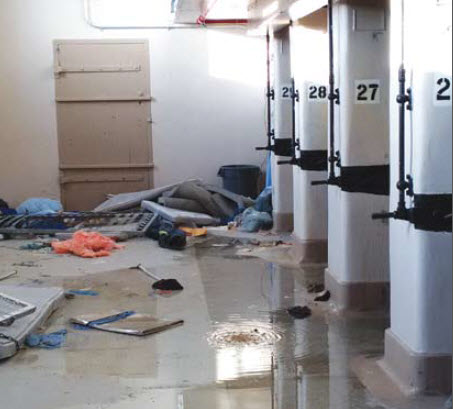
Investigator chastises CSC for failing to address complaints adequately prior to riot breaking out
Canada’s Correctional Investigator is laying the blame squarely at the feet of Correctional Services Canada (CSC) for last year’s deadly riot at Saskatchewan Penitentiary.
Ivan Zinger released his annual report earlier this week, and he took significant issue with food conditions and a broken dispute-resolution process that eventually escalated into the “full-scale” riot that left one inmate dead and sent eight more to the hospital.
Damage to some units was so extensive they were left “uninhabitable.”
“Current research suggests that a lot must go wrong, and for quite some time, before a prison erupts in violence,” Zinger wrote in his report.
“Prison administrators have opportunity and warning to address precipitating factors and thereby prevent a full-fledged riot from occurring in the first place. Prison riots are not random or inevitable. They are most likely to occur when a certain threshold of defiance and desperation is reached among a group of prisoners who take matters into their own hands to violently force change or express a long-standing grievance.”
According to the report, there were several demands and complaints made by inmates unhappy with the food, whether it be due to shortages, replacement items, position size or protein allotment. There was also a perceived mistreatment of inmate kitchen workers by CSC staff. Zinger found that last-minute attempts to resolve the issues failed, and tensions escalated. Demands and ultimatums were made on both sides, inmates refused to work and the warden ordered a lockdown.
When the inmates were called to work, they began to riot.
The investigator asked CSC to look into several factors, including the volume and nature of inmate complaints, timely response and resolution of systemic issues, an analysis of disciplinary actions taken and the frequency of disruptions in normal routine.
He also requested that CSC look at the degree of force used in response to events like the riot, as more than 36 kg of pepper spray was used by the guards to get inmates under control. He also questioned whether the use of firearms was necessary, proportionate and reasonable.
Immediately after the riot itself, the correctional investigator’s office sent two senior investigators to Sask. Pen. To identify causes of the riot, and monitor and assess the response.
They immediately noticed prisoners were sleeping in contaminated clothing and bedding, and there were issues with the provision of basic living necessities and access to legal council.
Right away, the office recommended that food quality meets national standards, open dialogue is maintained between management and inmates and the relationships within the kitchen are improved.
Zinger did commend measures taken to deal with outstanding disciplinary charges and recognize how quickly the prison worked to return to normal operations.
Still, he said, it’s clear much more work needs to be done.
“That said, the high number of complaints brought forward to our Office as well as continuing general unrest at this facility suggests that problems of a systemic nature persist. Incredibly, follow-up visits by this Office have noted continuing issues with food at this facility.”
He took note that Sask. Pen and Stony Mountain are two of the largest and oldest federal penitentiaries in Canada, and house large populations of Indigenous people.
He had stern words for conditions at those two facilities.
“The antiquated conditions of confinement that prevail in these two institutions are not conducive to modern and humane correctional practice, nor responsive to the unique needs of Indigenous prisoners.”
Concluding his look at the incident at Sask. Pen., Zinger recommended that lessons learned from the investigation into the incident be “widely circulated” within CSC and released to the public. He also took a deeper look at the state of food services within the national corrections system.
He detailed the efforts taken by the previous federal government to save $6.4 million in food costs in federal prisons as a part of the deficit reduction plan.
The daily cost to feed an inmate each day is $5.41. They’re given 2,600 calories a day, sufficient for a low-activity man aged 31 to 50.
“When the changes were introduced, inmate grievances related to food spiked,” Zinger said.
“This office is still receiving complaints related to food portion size, quality, selection and substitution of items. Young men up to age 30, who still make up the majority population in federal penitentiaries, require more than the average number of calorie and protein. That simply means more food.”
Zinger recommended CSC have an external audit done on their food services to resolve the complaints and, hopefully, lessen the chance of a riot in the future.
Attached to Zinger’s report was the CSC’s response to his recommendations.
Once CSC’s investigation into the riot is complete, they will send out a bulletin to share any lessons learned from the riot. A summary of the investigation will also be circulated within CSC and released to the public in December.
CSC is also planning an internal audit of food services to be published in the second half of 2018. The agency said they will take the investigator’s recommendation into consideration.

